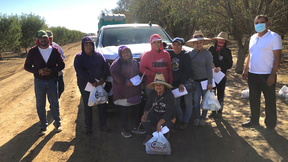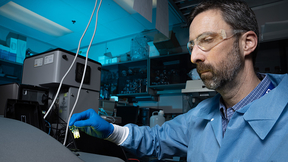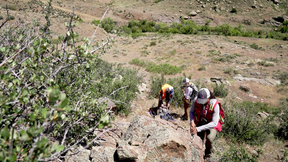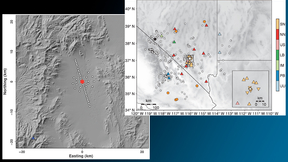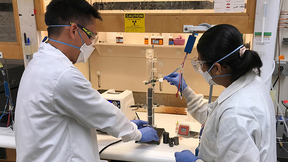Back
Brain-on-a-chip (BOC) systems are engineered cell-culture models that allow non-invasive, real-time monitoring of electrochemical processes. While newer 3D BOC systems have improved the neuronal viability, neural network activity, drug responses, and resemblance to disease pathology compared to their 2D counterparts, the ability to monitor the functional dynamics of the…
Pancreatic ductal adenocarcinoma (PDAC) is one of the deadliest types of cancer with a limited survival rate of about 10% over five years. In general, by the time a patient presents symptoms, the disease has advanced to a surgically unresectable stage and likely metastasized to other vital organs leading to rapid mortality. Since conventional chemotherapy prolongs patients…
Lawrence Livermore National Laboratory (LLNL) scientist and head of the Lab’s Carbon Initiative Jennifer Pett-Ridge has been selected as a fellow of the Ecological Society of America (ESA). ESA designates fellows of the society for certain members who have made outstanding contributions to a wide range of fields served by ESA. Pett-Ridge was selected for her work in soil…
Lawrence Livermore National Laboratory (LLNL) will provide technical assistance to 30 disadvantaged communities in west Fresno County to provide a future in clean-energy projects, including carbon capture and storage. The project is part of the Department of Energy’s Local Energy Action Program (LEAP) that aims to facilitate sustained community-wide economic and…
Lawrence Livermore National Laboratory’s (LLNL) Pandora SmallSat mission recently passed NASA’s critical design review: a major milestone for the mission to continue its journey toward launch. The Pandora SmallSat mission will study planets beyond our solar system, known as exoplanets, and their stars. “This is a major milestone for the mission and a huge accomplishment…
As a grid-scale energy storage system, flow batteries have gained increasing attention as a means to address the challenges associated with fluctuations and intermittency in renewable energy sources. Vanadium redox flow batteries (VRFBs) have emerged as promising solutions for stationary grid energy storage due to their high efficiency, scalability, safety, near room…
Kurt Dreger’s superhero costume would have an “s” on it — for safety, not Superman — for doing everything he can to protect workers at Lawrence Livermore National Laboratory (LLNL). The assurance manager and directorate security officer’s impressive resume includes stints as a certified industrial hygienist and an environment safety and health management professional and…
The severely invasive nature of combat trauma creates massive regions of injury, colonization and infection, requiring specialized diagnostic and aggressive therapeutic approaches. Previous reports indicate an estimated occurrence of wound infections in 18%–25% of combat-related injuries. Hindering wound recovery are multidrug-resistant microorganisms, which have been…
On Monday, April 8, a swath of North America will experience a total solar eclipse. For a few minutes, the moon will completely obscure the sun and viewers will be able to see the intricate loops and flares in the solar corona—normally washed out by the bright disk of the sun. In the corona, the outermost, gaseous part of the sun’s atmosphere, particles dance around…
Lawrence Livermore National Laboratory (LLNL) materials scientist Kate Elder has been selected as a Fulbright U.S. Scholar and will conduct research in Finland. Elder’s project, “Establishing Process-Structure Links During Additive Manufacturing of High Entropy Alloys,” will lead to the manufacture of lighter and stronger parts, perfect for high-temperature applications…
Getting the chance to meet and mingle with scientists who have achieved Nobel Prize winning greatness will be the reality for five Lawrence Livermore National Laboratory (LLNL) postdoctoral appointees selected to attend the 73rd annual Lindau Nobel Laureate meetings. Tina Ebert, Elizabeth Grace and Raspberry Simpson were selected as the 2024 LLNL cohort; Tomi Akindele and…
If the sun is too bright, you might don a pair of sunglasses or a hat to prevent glare from damaging your eyes. Researchers at Lawrence Livermore National Laboratory (LLNL) are using this same strategy to mitigate damage to valuable optics vital to the National Ignition Facility (NIF). Every time NIF fires, its lasers can harm the optics along its beamlines, causing…
A Lawrence Livermore National Laboratory (LLNL) researcher and a colleague who helped him and his team commercialize their biomedical technology have garnered a national technology transfer award. The award, from the Federal Laboratory Consortium (FLC), represents the 42nd technology transfer award that LLNL has won from the FLC since 1985. LLNL biologist Nicholas Fischer,…
Editor’s note: The principal mission of Lawrence Livermore National Laboratory (LLNL)’s National Ignition Facility (NIF) is to support the National Nuclear Security Administration’s science-based Stockpile Stewardship Program — and with the achievement of fusion ignition in 2022 at NIF, LLNL is further exploring the possible use of nuclear fusion as a future energy source…
Using a bioengineered protein-based technology, Lawrence Livermore National Laboratory (LLNL) scientists and collaborators will develop a new separation technique that ultimately will increase the concentration of rare-earth elements (REE) so they are more readily available to the defense sector. Under the Defense Advanced Research Projects Agency (DARPA) Environmental…
In a special issue of the Bulletin of the Seismological Society of America, Lawrence Livermore scientists describe recent work in seismoacoustics, an area of research that uses observations of both seismic and low-frequency acoustic waves (infrasound) to differentiate between earthquakes and other shallow underground or surface sources like explosions and volcanoes. Both…
Microalgae play important roles in global carbon cycling and industrial applications for bioproduct and biofuel production. As with land plants and other host–microbial systems, microalgal activity, productivity, and stability are closely tied to surrounding microbial communities. However, a predictive understanding of microbial community interactions with algae is still…
Particulate soil carbon may be more vulnerable to microbial decomposition under warmer temperatures associated with climate change. Soil organic matter contains more carbon than plants and the atmosphere combined. Soil is increasingly considered for its potential role in climate mitigation due to its ability to sequester more carbon, but it also is critical to understand…
Four Lawrence Livermore National Laboratory (LLNL) researchers have partnered with Los Angeles-based SoCalGas and Munich, Germany-based Electrochaea to develop an electrobioreactor to allow excess renewable electricity from wind and solar sources to be stored in chemical bonds as renewable natural gas. When renewable electricity supply exceeds demand, electric-utility…
Like a hidden enemy, pitting corrosion attacks metal surfaces, making it difficult to detect and control. This type of corrosion, primarily caused by prolonged contact with seawater in nature, is especially problematic for naval vessels. In a recent paper published in Nature Communications, Lawrence Livermore National Laboratory (LLNL) scientists delved into the mysterious…




